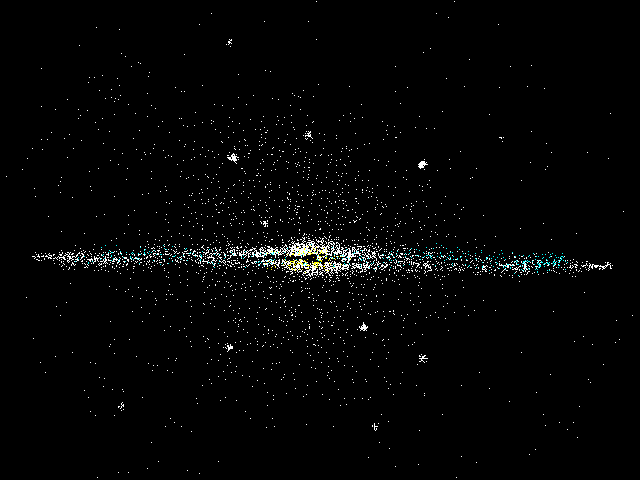How did the Galaxy get to be the way it is?
Recall what the Galaxy looks like.

Why?
A clue: Population I and Population II stars
The characteristics of the population of stars in the galaxtic disk
are not the same as the characteristics of halo stars (e.g. stars
in globular clusters).
- Disk stars (population I)
- Both heavy stars and light stars.
- A good supply of heavy elements.
- Halo stars (population II)
- Only light stars.
- Not much of heavy elements.
Recall another clue: gas is in the disk, not in the halo
Implication:
- Halo stars formed a long time ago.
- There probably were some heavy ones, but heavy stars don't live
long, so they are gone.
- A long time ago, the concentration of heavy elements was lower than
it is now in the disk, so the halo stars are low in heavy elements
- Disk stars formed later, and more are made continually.
- In particular, heavy stars are still made.
- After generations of star production, the heavy element concentration
has built up.
A basic hypotheses
- The Galaxy formed by gravitational attraction.
A plausible history
- Begin with a giant gas cloud .
- In small dense clouds within the big cloud,
stars and globular
clusters form.
- Slowly the big cloud is pulled together by gravity.
- The big cloud forms a disk.
- Angular momentum conservation causes it to rotate.
- Recall that gas clouds can
orbit in a disk without bumping into each other.
- The disk part continues to evolve by the cycle of new star
formation.
- Meanwhile,
halo stars can easily pass through the disk.
- Any gas in the halo part is removed when it
collides with the disk.
- This leaves a disk of gas and stars plus
a halo of stars without gas.
The broad outlines seem pretty clear. But the early stages are pretty
murky since the evidence has been erased.
What is the time scale for this?
- How long did it take?
- Time for Sun to orbit once around the center of the Galaxy is
approximately 200 x 106 years.
- That gives us a rough idea of how long it would take the matter to fall
toward the center of the Galaxy and form a disk.
- This suggests that the Galaxy could form pretty completely in 1000 x 106 = 1 x 109 years.
- When did it happen?

- The oldest things around should be the globular clusters.
- Massive stars die quickly, so look at a globular cluster and
ask ``how massive are the most massive stars that are still alive burning hydrogen in their cores.''
- Knowing from stellar models how long such a star should last gives
an estimate of the age of the globular cluster.
- Result: the age of globular clusters is in the range 12 x 109 years to 15 x 109 years.
- So that's about how old the Galaxy must be.
Davison E. Soper, Institute of Theoretical Science,
University of Oregon, Eugene OR 97403 USA
soper@bovine.uoregon.edu

